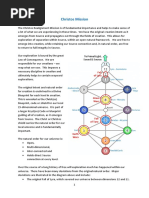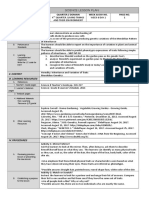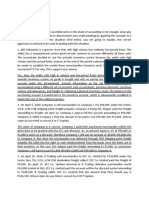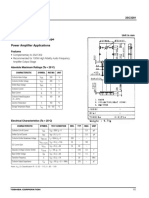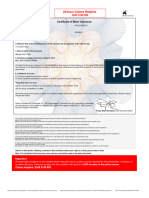Uge 1 Fifth Examination Questionnaire PDF
Uge 1 Fifth Examination Questionnaire PDF
Uploaded by
Lucky ArandaCopyright:
Available Formats
Uge 1 Fifth Examination Questionnaire PDF
Uge 1 Fifth Examination Questionnaire PDF
Uploaded by
Lucky ArandaOriginal Title
Copyright
Available Formats
Share this document
Did you find this document useful?
Is this content inappropriate?
Copyright:
Available Formats
Uge 1 Fifth Examination Questionnaire PDF
Uge 1 Fifth Examination Questionnaire PDF
Uploaded by
Lucky ArandaCopyright:
Available Formats
Student Name: ID #: Permit #:
Course: UGE 1 -READING COMPREHENSION Examination: FIFTH EXAMINATION Page: 1/7
College: CASE Term/ Semester: 2nd / 2nd S.Y: SY 2018-19
Total Points: 50 Exam Date: 2018-02-08
Instruction(s): Before you start, check the test paper for any missing pages. Then, go over the test
items and you may answer the easy questions first. Review your answers before you submit the test paper
and answer sheet to your teacher.
Directions: Read the passages below and answer the questions that follow.
Passage 1 (Passage 1 is adapted from Susan Milius, “A Different Kind of Smart.” ©2013 by Science News)
In 1894, British psychologist C. Lloyd Morgan published what’s called Morgan’s canon, the principle
that suggestions of humanlike mental processes behind an animal’s behavior should be rejected if a
simpler explanation will do.
Still, people seem to maintain certain expectations, especially when it comes to birds and mammals.
“We somehow want to prove they are as ‘smart’ as people,” zoologist Sara Shettleworth says. We want
a bird that masters a vexing problem to be employing human-style insight.
New Caledonian crows face the high end of these expectations, as possibly the second-best
toolmakers on the planet. Their tools are hooked sticks or strips made from spike-edged leaves, and
they use them in the wild to winkle grubs out of crevices. Researcher Russell Gray first saw the
process on a cold morning in a mountain forest in New Caledonia, an island chain east of Australia.
Over the course of days, he and crow researcher Gavin Hunt had gotten wild crows used to finding
meat tidbits in holes in a log. Once the birds were checking the log reliably, the researchers
placed a spiky tropical pandanus plant beside the log and hid behind a blind.
A crow arrived. It hopped onto the pandanus plant, grabbed the spiked edge of one of the long
strap-like leaves and began a series of ripping motions. Instead of just tearing away one long
strip, the bird ripped and nipped in a sequence to create a slanting stair-step edge on a leaf
segment with a narrow point and a wide base. The process took only seconds. Then the bird dipped
the narrow end of its leaf strip into a hole in the log, fished up the meat with the leaf-edge
spikes, swallowed its prize and flew off. That was my ‘oh wow’ moment,” Gray says. After the crow
had vanished, he picked up the tool the bird had left behind. “I had a go, and I couldn’t do it,”
he recalls. Fishing the meat out was tricky. It turned out that Gray was moving the leaf shard too
forcefully instead of gently stroking the spines against the treat.
The crow’s deft physical manipulation was what inspired Gray and Auckland colleague Alex Taylor to
test other wild crows to see if they employed the seemingly insightful string-pulling solutions
that some ravens, kea parrots and other brainiac birds are known to employ. Three of four crows
passed that test on the first try.
Passage 2 (Passage 2 is adapted from Bernd Heinrich, Mind of the Raven: Investigations and Adventures
with Wolf-Birds. ©2007 by Bernd Heinrich)
For one month after they left the nest, I led my four young ravens at least once and sometimes
several times a day on thirty-minute walks. During these walks, I wrote down everything in their
environment they pecked at. In the first sessions, I tried to be teacher. I touched specific
objects—sticks, moss, rocks—and nothing that I touched remained untouched by them. They came to
investigate what I had investigated, leading me to assume that young birds are aided in learning to
identify food from the parents’ example. They also, however, contacted almost everything else that
lay directly in their own paths. They soon became more independent by taking their own routes near
mine. Even while walking along on their own, they pulled at leaves, grass stems, flowers, bark,
pine needles, seeds, cones, clods of earth, and other objects they encountered. I wrote all this
down, converting it to numbers. After they were thoroughly familiar with the background objects in
these woods and started to ignore them, I seeded the path we would later walk together with objects
they had never before encountered. Some of these were conspicuous food items: raspberries, dead
meal worm beetles, and cooked corn kernels. Others were conspicuous and inedible: pebbles, glass
chips, red winterberries. Still others were such highly cryptic foods as encased caddisfly larvae
and moth cocoons. The results were dramatic.
The four young birds on our daily walks contacted all new objects preferentially. They picked them
out at a rate of up to tens of thousands of times greater than background or previously contacted
objects. The main initial criterion for pecking or picking anything up was its novelty. In
subsequent trials, when the previously novel items were edible, they became preferred and the
inedible objects became “background” items, just like the leaves, grass, and pebbles, even if they
were highly conspicuous. These experiments showed that ravens’ curiosity ensures exposure to all or
almost all items in the environment.
1. The underlined word vexing in the second paragraph of passage 1 means _____.
A.overwhelming
B.moving
© 2011 by College of Arts & Sciences Education (CASE), University of Mindanao
Student Name: ID #: Permit #:
Course: UGE 1 -READING COMPREHENSION Examination: FIFTH EXAMINATION Page: 2/7
College: CASE Term/ Semester: 2nd / 2nd S.Y: SY 2018-19
Total Points: 50 Exam Date: 2018-02-08
C.trembling
D.puzzling
2. To winkle in the third paragraph of passage 1 means _____.
A.to remove
B.to plant
C.to mix
D.to burry
3. The word spiked in the fourth paragraph of passage 1 is used as a _____.
A.noun
B.adjective
C.adverb
D.verb
4. The underlined word ripped in the fourth paragraph of passage 1 means _____.
A.criticized
B.rushed
C.tore
D.crawled
5. The underlined word nipped in the fourth paragraph of passage 1 means _____.
A.corrupted
B.squeezed
C.pinched
D.repaired
6. Which of the following word is an antonym of the word deft in the last paragraph of passage 1?
A.artful
B.skillful
C.ham-fisted
D.adroit
7. The word pecked in the first paragraph of passage 2 means _____.
A.to pick up with the bill
B.to give a light kiss
C.to eat in big bites
D.to nag unceasingly
8. Clods in the first paragraph of passage 2 means _____.
A.soil
B.dust
C.sand
D.dirt
9. Cryptic in the first paragraph of passage 2 is synonymous with _____.
A.plain
B.palatable
C.murky
D.accessible
10. The word conspicuous in the last paragraph of passage 2 is the opposite of _____.
A.noisy
B.emphatic
C.catchy
D.obscure
11. Within Passage 1, the main purpose of the first two paragraphs is to __________.
A.offer historical background in order to question the uniqueness of two researchers’ findings
B.offer interpretive context in order to frame the discussion of an experiment and its results
introduce a scientific principle in order to show how an experiment’s outcomes validated that
C.
principle
D.present seemingly contradictory stances in order to show how they can be reconciled empirically
12. According to the experiment described in Passage 2, whether the author’s ravens continued to show
interest in a formerly new object was dictated primarily by whether that object was __________.
A.edible
B.plentiful
C.conspicuous
D.natural
© 2011 by College of Arts & Sciences Education (CASE), University of Mindanao
Student Name: ID #: Permit #:
Course: UGE 1 -READING COMPREHENSION Examination: FIFTH EXAMINATION Page: 3/7
College: CASE Term/ Semester: 2nd / 2nd S.Y: SY 2018-19
Total Points: 50 Exam Date: 2018-02-08
13.
The crows in Passage 1 and the ravens in Passage 2 shared which trait?
A.They modified their behavior in response to changes in their environment.
B.They formed a strong bond with the humans who were observing them.
C.They manufactured useful tools for finding and accessing food.
D.They mimicked the actions they saw performed around them.
14. One difference between the experiments described in the two passages is that unlike the researchers
discussed in Passage 1, the author of Passage 2 __________.
A.presented the birds with a problem to solve
B.intentionally made the birds aware of his presence
C.consciously manipulated the birds’ surroundings
D.tested the birds’ tool-using abilities
15. Is the main conclusion presented by the author of Passage 2 consistent with Morgan’s canon, as
described in Passage 1?
Yes, because the conclusion proposes that the ravens’ behavior is a product of environmental
A.
factors.
B.Yes, because the conclusion offers a satisfyingly simple explanation of the ravens’ behavior.
C.No, because the conclusion suggests that the ravens exhibit complex behavior patterns.
D.No, because the conclusion implies that a humanlike quality motivates the ravens’ behavior.
Directions: For items no. 16-25, refer to passage 2. Given below are sets of events that happened but
NOT in order. Identify the event that happened first, next and so on. Put X on the box which corresponds
to the correct answer for each item asked.
A. I wrote all this down, converting it to numbers.
B. For one month after they left the nest, I led my four young ravens at least once and sometimes
several times a day on thirty-minute walks.
C. I touched specific objects—sticks, moss, rocks—and nothing that I touched remained untouched
by them.
D. After they were thoroughly familiar with the background objects in these woods and started to
ignore them, I seeded the path we would later walk together with objects they had never before
encountered.
E. Even while walking along on their own, they pulled at leaves, grass stems, flowers, bark, pine
needles, seeds, cones, clods of earth, and other objects they encountered.
16. Which should be the first sentence?
A.E
B.A
C.D
D.B
17. Which should be the fifth sentence?
A.E
B.D
C.B
D.C
18. Which should be the third sentence?
A.E
B.B
C.D
D.A
19. Which should be the second sentence?
A.E
B.C
C.D
D.A
20. Which should be the fourth sentence?
A.E
B.C
C.D
D.A
© 2011 by College of Arts & Sciences Education (CASE), University of Mindanao
Student Name: ID #: Permit #:
Course: UGE 1 -READING COMPREHENSION Examination: FIFTH EXAMINATION Page: 4/7
College: CASE Term/ Semester: 2nd / 2nd S.Y: SY 2018-19
Total Points: 50 Exam Date: 2018-02-08
F. The four young birds on our daily walks contacted all new objects preferentially.
G. These experiments showed that ravens’ curiosity ensures exposure to all or almost all items in
the environment.
H. Others were conspicuous and inedible: pebbles, glass chips, red winterberries.
I. In subsequent trials, when the previously novel items were edible, they became preferred and the
inedible objects became “background” items, just like the leaves, grass, and pebbles, even if they
were highly conspicuous.
J. The main initial criterion for pecking or picking anything up was its novelty.
21. Which should be the last sentence?
A.J
B.F
C.I
D.G
22. Which should be the sixth sentence?
A.F
B.I
C.G
H
D.
23. Which should be the ninth sentence?
A.J
B.G
C.I
F
D.
24. Which should be the eighth sentence?
A.J
B.H
C.I
D.F
25. Which should be the seventh sentence?
A.J
B.H
C.I
D.F
Directions: For items no. 26-35, refer to given sets of EFFECTS and CAUSES stated in each item. Match
the CAUSES provided in each item to its given set of EFFECTS. Put X on the box which corresponds to the
correct answer for each item.
EFFECTS
a. She was hungry at lunch.
b. He was sleepy the next day.
c. Chris got wet.
d. The teacher gave them a reward.
e. Another car hit it.
CAUSES
26.
The car ran a red light.
A.a
B.e
C.b
D.c
27. Ben stayed up late.
A.a
B.e
C.b
D.c
© 2011 by College of Arts & Sciences Education (CASE), University of Mindanao
Student Name: ID #: Permit #:
Course: UGE 1 -READING COMPREHENSION Examination: FIFTH EXAMINATION Page: 5/7
College: CASE Term/ Semester: 2nd / 2nd S.Y: SY 2018-19
Total Points: 50 Exam Date: 2018-02-08
28. The students were quiet in class.
A.a
B.e
C.b
D.d
29. It rained.
A.a
B.e
C.b
D.c
30. Lydia skipped breakfast.
A.a
B.e
C.b
D.c
EFFECTS
a. The horses were thirsty.
b. She fell down.
c. It boiled over.
d. Everyone laughed.
e. It sank.
CAUSES
31. It was very hot outside.
A.a
B.e
C.b
D.c
32. Lucy’s shoes were not tied.
A.a
B.e
C.b
D.c
33. The boat had a leak.
A.a
B.e
C.b
D.c
34. The puppy chased its tail.
A.a
B.d
C.b
D.c
35. There was too much water in the pot.
A.a
B.e
C.b
D.c
Directions: For items no. 36-43, read the selection below and answer the following questions. Put x on
the box which corresponds to the correct answer.
The study of history provides many benefits. First, we learn from the past. We may repeat mistakes,
but, at least, we have the opportunity to avoid them. Second, history teaches us what questions to
ask about the present. Contrary to some people’s view, the study of history is not the memorization
of names, dates, and places. It is the thoughtful examination of the forces that have shaped the
courses of human life. We can examine events from the past and then draw inferences about current
events. History teaches us about likely outcomes.
© 2011 by College of Arts & Sciences Education (CASE), University of Mindanao
Student Name: ID #: Permit #:
Course: UGE 1 -READING COMPREHENSION Examination: FIFTH EXAMINATION Page: 6/7
College: CASE Term/ Semester: 2nd / 2nd S.Y: SY 2018-19
Total Points: 50 Exam Date: 2018-02-08
Another benefit of the study of history is the broad range of human experience which is covered.
War and peace are certainly covered as are national and international affairs. However, matters of
culture (art, literature, and music) are also included in historical study. Human nature is an
important part of history: emotions like passion, greed, and insecurity have influenced the shaping
of world affairs. Anyone who thinks that the study of history is boring has not really studied
history.
36. What is the main idea of this passage?
A.Studying history helps us to live in today’s world.
B.Studying history is not just memorization.
C.The role of education is to help students deal with real life.
D.Students should study both national and international history.
37. In the first paragraph, inferences means __________.
A.graphs
B.articles
C.conclusions
D.circumferences
38. Which method of teaching history would the author of this passage support?
A.Applying historical events to modern society.
B.Using flash cards to remember specific facts.
C.Weekly quizzes on dates and events.
D.Student competitions for most books memorized.
39. Which of the following sentence is NOT TRUE?
A.Our history is beneficial to all.
B.We should learn from our past.
C.History teaches us lessons in life.
D.Matters of culture sometimes part of human history.
40. Which of the following statement is TRUE.
A.History is boring.
B.Everyone studied history.
C.History must be the priority of the curriculum.
D.History is the reflection of the past, the present, and the future.
41. Which of the four sentences is grammatically correct?
A.One of the musicians who is Eric has been looking for a practice room.
B.Eric, one of the musicians, are looking for a practice room.
C.Eric who is one of the musicians who are looking for a practice room.
D.Eric, one of the musicians, is looking for a practice room.
42. The workers left early and ___________home.
A.gone
B.went
C.have dinner
D.drives
43. The traffic was heavy. I was late to work.
A.I was late to work because the traffic was heavy.
B.I was late to work, so the traffic was heavy.
C.The traffic was heavy, I was late to work.
D.The traffic was heavy: and then I was late to work.
Sentence and Syntax Skills Test. This test consists of a cloze type passage. These selections have words
missing, and students are asked to select the correct word. This measures a combination of students’
reading and writing skills such as using context and understanding syntax.
Directions: For item numbers 44-46, refer to Passage 1. For item numbers 47-50, refer to Passage 2. Put
X on the box that corresponds to the letter of the correct answer.
Passage 1
It used to be common for dentists to have to remove teeth. However, with modern technology, (44)
_______________ visits to the dentist’s office and good (45) _______________hygiene at home, most
people can keep (46) _______________teeth for their lives.
© 2011 by College of Arts & Sciences Education (CASE), University of Mindanao
Student Name: ID #: Permit #:
Course: UGE 1 -READING COMPREHENSION Examination: FIFTH EXAMINATION Page: 7/7
College: CASE Term/ Semester: 2nd / 2nd S.Y: SY 2018-19
Total Points: 50 Exam Date: 2018-02-08
44.
Item No. 44
A.the
B.infrequent
C.regular
D.often
45. Item No. 45
A.dental
B.person
C.cleaning
D.tooth
46. Item No. 46
A.their
B.his
C.front
D.cleaned
Passage 2
In the 16th century, an age of great marine and terrestrial exploration, Ferdinand Magellan led the
first expedition to _______________ [47] the world. As a young Portuguese noble, he served the king
of Portugal, but he became involved in the quagmire of political intrigue at court and lost the
king’s favor. After he was dismissed from service by the king of Portugal, he offered to serve the
future Emperor Charles V of Spain.
A papal decree of 1493 had assigned all land in the New World west of 50 degrees W longitude to
Spain and all the land east of that line to Portugal. Magellan offered to prove that the East
Indies fell under Spanish authority. On September 20, 1519, Magellan set sail from Spain with five
ships. More than a year later, _______________ [48] exploring the topography of South America in
search of a water route _______________ [49]. This ship sank, but the remaining four ships searched
along the southern peninsula of South America. Finally they found the passage they sought near 50
degrees S latitude. Magellan named this passage the Strait of All Saints, but today it is known as
the Strait of Magellan.
One ship deserted while in this passage and returned to Spain, so fewer sailors were privileged to
gaze at that first panorama of the Pacific Ocean. Those who remained crossed the meridian now
_______________ [50] the International Date Line in the early spring of 1521 after 98 days on the
Pacific Ocean. During those long days at sea, many of Magellan’s men died of starvation and disease.
Later, Magellan became involved in an insular conflict in the Philippines and was killed in a
tribal battle. Only one ship and 17 sailors under the command of the Basque navigator Elcano
survived to complete the westward journey to Spain and thus prove once and for all that the world
is round, with no precipice at the edge.
47. Item No. 47
A.sail along
B.sail beneath
C.sail around
D.sail through
48. Item No. 48
A.one of the ships was
B.one of these ships was
C.one of the ship was
D.one of these ships were
49. Item No. 49
A.within the continent
B.around the continent
C.through the continent
D.across the continent
50. Item No. 50
A.known as
B.known for
C.known in
D.known of
© 2011 by College of Arts & Sciences Education (CASE), University of Mindanao
You might also like
- Detailed Lesson Plan in Science 8Document6 pagesDetailed Lesson Plan in Science 8Cristine roquero84% (25)
- Christos MissionDocument15 pagesChristos MissionRha Liason92% (38)
- Grade 1 Elevate Science Workbook - 1327551514 - 225 - 433184428Document44 pagesGrade 1 Elevate Science Workbook - 1327551514 - 225 - 433184428Mahmoud SolimanNo ratings yet
- Let's Check: Predicted Discharge - 7792 + (4.226 X Year)Document4 pagesLet's Check: Predicted Discharge - 7792 + (4.226 X Year)Lechon Manok100% (1)
- UGE Practice Set 1Document14 pagesUGE Practice Set 1Jeany Jatico Salazar92% (13)
- Mathematics in Modern World ULO1-dDocument2 pagesMathematics in Modern World ULO1-dApollos Jason S. OjaoNo ratings yet
- Mathematics in The Modern World: Scatterplot of Stories (X) and Height (Y)Document5 pagesMathematics in The Modern World: Scatterplot of Stories (X) and Height (Y)JOHN DAVE BANTAYAN100% (3)
- First Exam RizalDocument8 pagesFirst Exam RizalMervin BauyaNo ratings yet
- UGE Practice Set - Cause and Effect Rev 1Document7 pagesUGE Practice Set - Cause and Effect Rev 1Reynaldo Sabandal100% (6)
- UGE 1 Practice Set Worksheet - 2author's PurposeDocument18 pagesUGE 1 Practice Set Worksheet - 2author's PurposeKit Kit100% (3)
- Practice Set 1 MineDocument6 pagesPractice Set 1 MineGericho Diapana100% (3)
- ULOa CheckDocument4 pagesULOa CheckLechon Manok100% (2)
- Activity 2.3 Matching Type: Match Column A To Column B. Write The Letter in The Space ProvidedDocument2 pagesActivity 2.3 Matching Type: Match Column A To Column B. Write The Letter in The Space ProvidedAmamore Lorenzana Plaza60% (5)
- Ula AnalyzeDocument7 pagesUla AnalyzeLechon Manok50% (2)
- Assignment 1 ULO 1 Wk1 AUSADocument5 pagesAssignment 1 ULO 1 Wk1 AUSArenato tuballaNo ratings yet
- Ge 4 MMW Week 6 7Document79 pagesGe 4 MMW Week 6 7JOHN DAVE BANTAYANNo ratings yet
- Grade Level Quarter / Domain Week & Day No. Page No. 1: Science Lesson PlanDocument6 pagesGrade Level Quarter / Domain Week & Day No. Page No. 1: Science Lesson PlanCristine roquero100% (2)
- Carver Hydraulic Press ManualDocument38 pagesCarver Hydraulic Press Manualgotboost777No ratings yet
- Uge 1 6TH Examination Questionnaire PDFDocument6 pagesUge 1 6TH Examination Questionnaire PDFLucky Aranda100% (2)
- Uge 1 - Fourth Examination PDFDocument5 pagesUge 1 - Fourth Examination PDFLucky Aranda100% (1)
- Uge 1 - Fourth ExaminationDocument5 pagesUge 1 - Fourth ExaminationLucky Aranda60% (5)
- UGE Practice Set - Comparison and Contrast Rev1Document9 pagesUGE Practice Set - Comparison and Contrast Rev1Reynaldo Sabandal78% (9)
- Ge15 Final ReviewerDocument15 pagesGe15 Final ReviewerDevon Pornadia100% (1)
- UGE Practice Set - Getting The Main Idea Rev1Document5 pagesUGE Practice Set - Getting The Main Idea Rev1Reynaldo Sabandal100% (2)
- UGE Practice Set - Summarizing Rev1Document8 pagesUGE Practice Set - Summarizing Rev1Reynaldo Sabandal50% (2)
- LCAa 4 LoriaDocument4 pagesLCAa 4 Loriafaith loriaNo ratings yet
- ULO A - Let's Check and AnalyzeDocument2 pagesULO A - Let's Check and Analyzerenato tuballaNo ratings yet
- Let S Check 09 OHAO PDFDocument2 pagesLet S Check 09 OHAO PDFBeh BuriNo ratings yet
- UGE Practice Set - Sequencing Rev 1Document9 pagesUGE Practice Set - Sequencing Rev 1Reynaldo Sabandal100% (1)
- UGE 1 (Reading Comprehension) - FINALDocument12 pagesUGE 1 (Reading Comprehension) - FINALTon RJ Ido100% (2)
- UGE 1 Practice Set - Fact or OpinionDocument15 pagesUGE 1 Practice Set - Fact or OpinionSHEEN DEL ROSARIO100% (1)
- GE4Document1 pageGE4Kimmy StixNo ratings yet
- Ge 4 MMW Practice Set 5, A - FDocument6 pagesGe 4 MMW Practice Set 5, A - FAllysa Galang100% (2)
- Self-Instructional Manual (SIM) For Self-Directed Learning (SDL)Document140 pagesSelf-Instructional Manual (SIM) For Self-Directed Learning (SDL)adriane gabutan50% (2)
- Practice Sets UGE 1 Incomplete 5 14 21Document15 pagesPractice Sets UGE 1 Incomplete 5 14 21John Mark Salarda0% (1)
- The Following Poem Is by AlfredDocument6 pagesThe Following Poem Is by AlfredAgnes TungNo ratings yet
- Self-Instructional Manual (SIM) For Self-Directed Learning (SDL)Document33 pagesSelf-Instructional Manual (SIM) For Self-Directed Learning (SDL)BNo ratings yet
- GE4 - 3506 - Lets AnalyzeDocument4 pagesGE4 - 3506 - Lets AnalyzeKimmy Stix100% (2)
- In A NutshellDocument2 pagesIn A NutshellAlondra Manuay100% (1)
- Self-Instructional Manual (SIM) For Self-Directed Learning (SDL)Document83 pagesSelf-Instructional Manual (SIM) For Self-Directed Learning (SDL)BARCELON, CHRISTOPHER JAMESNo ratings yet
- Cultural EntrapmentDocument9 pagesCultural EntrapmentPaul Isaac Pareñas100% (1)
- WEEK6-7LA (Votacion)Document1 pageWEEK6-7LA (Votacion)Marybelle Torres Votacion100% (1)
- Acc111 (412) Activity28 MarimonDocument2 pagesAcc111 (412) Activity28 MarimonDonabelle MarimonNo ratings yet
- Management Science Midterm Exam 1ST Sem Ay2017-18Document4 pagesManagement Science Midterm Exam 1ST Sem Ay2017-18Uy SamuelNo ratings yet
- Name: Lourd Justin T. Delicana Course & Code: GE 4 (784) Geometric ShapesDocument7 pagesName: Lourd Justin T. Delicana Course & Code: GE 4 (784) Geometric ShapesLourd Justin Delicana100% (3)
- GSELFActivities On Material Self March 27Document2 pagesGSELFActivities On Material Self March 27Erika Sumawang100% (1)
- College of Arts and Sciences Education General EducationDocument18 pagesCollege of Arts and Sciences Education General EducationRerey Vales67% (6)
- Let's Check Activity 2.5Document2 pagesLet's Check Activity 2.5Amamore Lorenzana Plaza43% (7)
- Board Exam Readiness Survey: New Era UniversityDocument3 pagesBoard Exam Readiness Survey: New Era UniversityKurt Canero100% (1)
- My View of Duterte's Administration If I Were A UtilitarianDocument1 pageMy View of Duterte's Administration If I Were A UtilitarianJay Mark Blancada55% (20)
- Self-Instructional Manual (SIM) For Self-Directed Learning (SDL)Document116 pagesSelf-Instructional Manual (SIM) For Self-Directed Learning (SDL)broybroy suarez100% (1)
- Ge3 Module (Aps Approved Module)Document143 pagesGe3 Module (Aps Approved Module)Jan Matthew Albesa100% (1)
- GE 4-MMW-Week 1-3Document39 pagesGE 4-MMW-Week 1-3Roligeal Alcones0% (1)
- Answer Sample Problems Cash1-12Document4 pagesAnswer Sample Problems Cash1-12Anonymous wwLoDau1aNo ratings yet
- Lecture 1-Science and TechnologyDocument55 pagesLecture 1-Science and TechnologyJoana TrinidadNo ratings yet
- UM Tagum College: Self-Instructional Manual (SIM) For Self-Directed Learning (SDL)Document177 pagesUM Tagum College: Self-Instructional Manual (SIM) For Self-Directed Learning (SDL)Chara etangNo ratings yet
- UM Tagum College Vision Mission ValuesDocument11 pagesUM Tagum College Vision Mission ValuesRolan Lavadia IINo ratings yet
- Let's Analyze: Which Is The Effect. Write Your Answers On The Blanks ProvidedDocument1 pageLet's Analyze: Which Is The Effect. Write Your Answers On The Blanks ProvidedAdam CuencaNo ratings yet
- Semis and Finals MMWDocument40 pagesSemis and Finals MMWDexter BangayanNo ratings yet
- Pinansilo Let S Analyze Ulo B Week 6 7 Ge 4 4247Document13 pagesPinansilo Let S Analyze Ulo B Week 6 7 Ge 4 4247Vhinz PelenioNo ratings yet
- Let'S Check Activity No. 1. Now That You Have Know The Most Essential Terms in The Study ofDocument5 pagesLet'S Check Activity No. 1. Now That You Have Know The Most Essential Terms in The Study ofopxNo ratings yet
- Animal Lesson PlanDocument5 pagesAnimal Lesson Planapi-268661281No ratings yet
- ReferencesfinalDocument2 pagesReferencesfinalLucky ArandaNo ratings yet
- Lesson Plan SCIENCE 3Document5 pagesLesson Plan SCIENCE 3Lucky Aranda100% (1)
- Basic Concepts in Assessment: Traditional Assessment Portfolio Assessment Performance AssessmentDocument4 pagesBasic Concepts in Assessment: Traditional Assessment Portfolio Assessment Performance AssessmentLucky ArandaNo ratings yet
- Speech Communication: The Concept ofDocument18 pagesSpeech Communication: The Concept ofLucky ArandaNo ratings yet
- Brings You Into Contact With The Firsthand Accounts of EventsDocument1 pageBrings You Into Contact With The Firsthand Accounts of EventsLucky ArandaNo ratings yet
- Assessment of Learning 1 (ULOA - Reviewer) : EducationDocument13 pagesAssessment of Learning 1 (ULOA - Reviewer) : EducationLucky ArandaNo ratings yet
- Ge 8Document2 pagesGe 8Lucky ArandaNo ratings yet
- Jackal: User ManualDocument15 pagesJackal: User ManualIgor Batista VieiraNo ratings yet
- The Art of Natural Cheesemaking - Chapter One: A Natural Cheesemaking ManifestoDocument8 pagesThe Art of Natural Cheesemaking - Chapter One: A Natural Cheesemaking ManifestoChelsea Green PublishingNo ratings yet
- LIfe Cycle Assessment of Non-Dairy MilkDocument22 pagesLIfe Cycle Assessment of Non-Dairy MilkArman SaeedtaheriNo ratings yet
- Economic Development Chapter 5Document18 pagesEconomic Development Chapter 5ck64jxfz8kNo ratings yet
- Polymer Composite Materials For Wind Power TurbinesDocument8 pagesPolymer Composite Materials For Wind Power TurbinesKenneth HejlesenNo ratings yet
- 5qqmn938 - Week 2Document43 pages5qqmn938 - Week 2Rammani MandalNo ratings yet
- KCT ProfileDocument50 pagesKCT ProfileRathawit SingpanjanateeNo ratings yet
- Dashavidha Pareeksha With PareekshabhavaDocument60 pagesDashavidha Pareeksha With PareekshabhavaAbiskar AdhikariNo ratings yet
- Traffic Control Inspection FormDocument4 pagesTraffic Control Inspection FormzaherNo ratings yet
- BMC Child HealthDocument17 pagesBMC Child HealthDamesa MiesaNo ratings yet
- Complete Body Transformation Manual The Ultimate 12 Week Workout Plan Suitable For Women and Men Sean Lerwill PDF For All ChaptersDocument70 pagesComplete Body Transformation Manual The Ultimate 12 Week Workout Plan Suitable For Women and Men Sean Lerwill PDF For All Chapterswiggerannik55100% (12)
- Patricia Jean Rodriguez - Clinical Chemistry Board Review Set 2Document23 pagesPatricia Jean Rodriguez - Clinical Chemistry Board Review Set 2Patricia Jean RodriguezNo ratings yet
- Toshiba: Discrete SemiconductorsDocument2 pagesToshiba: Discrete SemiconductorsHla Swe OoNo ratings yet
- LJ MediaDocument3 pagesLJ MediaJerry ThompsonNo ratings yet
- Unmask by HagocimitDocument114 pagesUnmask by HagocimitAngelica LagunaNo ratings yet
- 2017 English DWDM Book 4 IntDocument5 pages2017 English DWDM Book 4 IntNia ShepiashviliNo ratings yet
- linear equation projectDocument6 pageslinear equation projectbyas26goswamiNo ratings yet
- Product Sheet GSM-5140Document1 pageProduct Sheet GSM-5140Kebo ElhaqNo ratings yet
- Policy Documents-F18410Document1 pagePolicy Documents-F18410Florin VaetusNo ratings yet
- 151602106-PGI Rohtak-Sushmita Singh Case StudyDocument11 pages151602106-PGI Rohtak-Sushmita Singh Case Studysushmita singhNo ratings yet
- Introduction To Next-Generation Sequencing TechnologyDocument12 pagesIntroduction To Next-Generation Sequencing TechnologyRog DonNo ratings yet
- Module 1 Ehs NotesDocument12 pagesModule 1 Ehs NotesashmerkmNo ratings yet
- Riyadh International Convention & Exhibition Center: Organized byDocument6 pagesRiyadh International Convention & Exhibition Center: Organized byWafa MersniNo ratings yet
- Module 2 PATHFit 1Document11 pagesModule 2 PATHFit 1gabriel.cayabyab26No ratings yet
- Transaction ReportDocument4 pagesTransaction ReportKandyeppa k KandyeppaNo ratings yet
- FakinasolDocument17 pagesFakinasolmasgontarNo ratings yet
- God in A Man j4j7xkDocument187 pagesGod in A Man j4j7xkbezaleelnana25No ratings yet
- Oxygen Toxicity: January 2006Document11 pagesOxygen Toxicity: January 2006Dana, BNNo ratings yet

